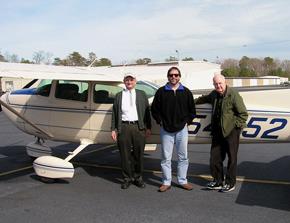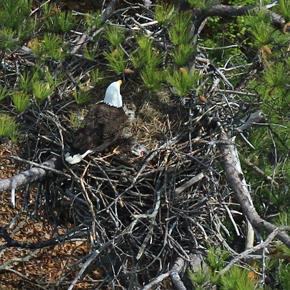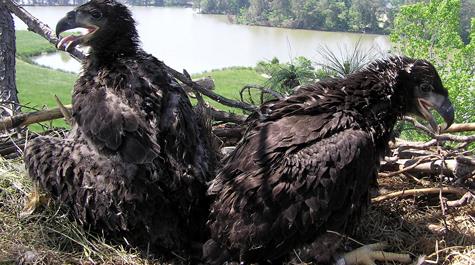An eagle anniversary at the alma mater of the national bird
Mitchell Byrd and Bryan Watts have earned a number of insights into the domestic arrangements of bald eagles nesting in Virginia’s coastal plain.
Byrd and Watts have been two members of a three-man team that has been doing annual aerial census surveys of nesting bald eagles throughout the region. Watts, director of the Center for Conservation Biology, is conducting his 25th year of the flights, while Byrd is celebrating his 40th year. Watts and Byrd co-founded the Center for Conservation Biology at William & Mary in 1992.
 The third member of the team is a former fighter pilot who goes by the name of Capt. Fuzzzo. (The middle z, he says, is silent.) Capt. Fuzzzo, the new guy, has been piloting for the census flights for 24 years.
The third member of the team is a former fighter pilot who goes by the name of Capt. Fuzzzo. (The middle z, he says, is silent.) Capt. Fuzzzo, the new guy, has been piloting for the census flights for 24 years.
Byrd, the Chancellor Professor Emeritus in the Department of Biology, began the census flights in 1977. The regional bald eagle population, he explained, was just starting to recover after the banning of DDT pesticide and being automatically placed on the new federal Endangered Species List in 1973. At that time there were 33 pairs of bald eagles breeding in coastal Virginia.
“And there were none on the James,” he recalled. “We flew several years without seeing a nest on the James. It got pretty frustrating.”
The methodology is the same as when Byrd first began the flights, “when it was me, a pilot and a sick student in the back.” Watts is the spotter. Byrd sits in the copilot seat with a stack of topographic maps, marking down each sighting. Capt. Fuzzzo flies the plane at an altitude low enough for Watts to spot the nest and its occupants.
The team flies two sets of flights, one in late February-early March, to scout out new eagle nests and to check the status of known nests. A second set, in late April, counts chicks that have been hatched. Some stretches are more densely populated than others, resulting in some frantic scenes inside Capt. Fuzzzo’s Cessna.
“On the upper James, for instance, starting about at Williamsburg and going on up toward Richmond, it’s pretty intense,” Watts said. “It’s make-your-head-spin intense. The nests are packed in so tight, the distance between them is seconds. People don’t realize the concentration that it takes.”
The eagles have done better than anyone could have imagined, Watts said. There are more eagles in the Chesapeake Bay area now than there have been since Colonial times — and the James River is now one of the region’s most productive areas for nesting eagles. The eagle recovery team in the 70s had set a recovery goal of 300 breeding pairs in the Bay. Watts said the 300-pairs goal was based on a long-depressed population, about which there wasn’t much hard data. Byrd called the goal “mostly a wild guess.”
“The DDT was just the last bad chapter in a bad book for the eagles,” Watts said. “There were shootings. There was a lot of deforestation in the post-Civil War period. And now we have completely come out of that.”
 Today, the tidal reach of the Chesapeake is home to more than 2,000 breeding pairs of the national bird. The comeback is due to a number of factors, not least of which is reforestation.
Today, the tidal reach of the Chesapeake is home to more than 2,000 breeding pairs of the national bird. The comeback is due to a number of factors, not least of which is reforestation.
“In 1977, when Mitchell started doing these flights, most of the birds were nesting in what we call ‘survivor trees,’” Watts said, going on to explain that such large trees date back to the Civil War period and are rare on the landscape.
“But now, through secondary succession, many of the trees that were planted in the post-Civil War period are getting to the stature where they can support nests,” he said. “That’s another thing that I think has contributed to the recovery.”
Bald eagles have a number of preferences when it comes to nesting. As the eagle population increases, Byrd and Watts have become quite familiar with the bald eagle real estate market. The ideal nesting tree, they say, has a characteristic known as “crown access.”
“By that we mean a large tree where the crown is above everything else,” Watts said. “That’s a key factor. Eagles have large wingspans and they don’t like to fly through tight spaces.”
A clear, unobstructed flight path to the nest seems to be much more important to eagles than the absolute height of the nest. As the eagle population of the Bay has grown, prime nesting sites have become scarce and the choices of birds crowded out of the premier real estate of the area still reflect the importance the birds place on the accessibility of the nest.
They found one eagle pair nesting on a channel marker — Byrd lost a bet with a student on that one — and another pair nested on the open ground.
An eagle nest can weigh upwards of two tons and requires a sturdy tree to support it, and Watts said the most favored nest trees display a scaffolding structure in the upper branches to make a good foundation for the birds.
The flights have revealed significant differences between older, experienced parents and younger birds. For one thing, the experienced eagles lay eggs earlier and therefore tend to get the best nesting trees. Watts said the eagles trying to breed in the suboptimum nesting sites, such as the ground nester and the channel marker birds, are virtually always inexperienced eagles who couldn’t find a more suitable location.
“There is about a month span between older adult nesters and young birds,” Watts said. “Newly established territories with young birds tend to be later nesters and less productive. They’re learning.”
The older birds have sheer experience on their side, and Watts pointed out that early breeding gives them a significant reproductive advantage by offering a pair a second chance if something goes wrong with their first clutch of eggs.
“We always have a certain number of failures,” he said. “At this latitude, some of the early-breeding birds will go ahead and have another clutch. Once you get up to New England, that doesn’t happen any more. They have a shorter breeding season.”
Both Watts and Byrd say that the repopulation of bald eagles in the Chesapeake Region is the greatest success story in American conservation. The eagle population has reached saturation point around the Bay and the population is spreading to all parts of the country.
“We’re seeing the result of decisions that were made in the 1960s and 1970s. It’s hard to imagine now, with all the political gridlock,” Watts said, “but Americans got behind eagles at that time and they made the right decisions.”
The Center for Conservation Biology is a joint program of William & Mary and Virginia Commonwealth University.
 Skip to main content
Skip to main content

